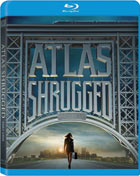BLU-RAY REVIEW

Atlas Shrugged: Part I
Featured In Issue 175, March 2013
Atlas Shrugged: Part I is based on Ayn Rand's 1957 novel. The year is 2016 and America is on the verge of economic disaster. The greatest citizens are being targeted, and dark forces are working to bring about America's final days. These key people who had once kept our world running are disappearing all over the country. Society and cities are depressed and inoperable. Only misery persists. No one knows how to stop it, no one understands why it is happening. Our only hope for salvation lies with Dagny Taggart (Schilling), the rugged individualists-co-family owner of a once mighty transcontinental railroad, and Henry Rearden (Bowler), the steel magnate owner. As Taggart struggles to keep her railroad business alive while society is crumbling around her, the two join forces in support of bold ideas that may have the power to spark a revolution and reclaim the American Dream. (Gary Reber)
Special features include commentary with Producer John Aglialoro, Writer Brian Patrick O'Toole, and Producer Harmon Kaslow; the featurette Road To Atlas Shrugged (HD 05:13); I Am John Galt (HD 35:11); The John Galt Slide Show; and upfront previews.
The 2.35:1 1080p AVC picture was photographed digitally with the Red One MX camera system, with the feel of a made-for television movie. The image quality is decent, with well-balanced contrast, with deep blacks and revealing shadow delineation. The color palette appears naturally hued with warm tones. Resolution is good, with sharp and clear images of facial features, hair, clothing, and object texture. While there are a few soft shots, there is no objectionable digital noise. While not impressively cinematic, the presentation is tasteful and pleasing as a visual experience. (Gary Reber)
The DTS-HD Master Audio™ 5.1-channel soundtrack, while often frontal focused, does manage to create a sense of soundfield dimension. Atmospherics and sound effects are most prominent during the scenes of the Colorado run on the Taggart Transcontinental trains on the John Galt railroad. In addition, the orchestral music score provides an enveloping sense of spatial dimension, with its presence in the surround channels. Deep bass in the .1 LFE channel punctuates a number of segments and provides a solid foundation. Dialogue is natural sounding, though, at times is lost due to low levels. Overall, this is a supportive mix. (Gary Reber)

 then "Add to Home Screen"
then "Add to Home Screen"